We left off on last week’s update in Basseterre, the main town on St Kitts. After having done the touristy stuff in that area, we headed to the southern end of St. Kitts for a well recommended anchorage named White House Bay. While we didn’t find a single house on the shoreline, white or otherwise, we did find remnants of an old dock which presented itself as we landed the dinghy. We took this opportunity to get another workout for our muscles by walking around a rather large salt pond. Now, we’ve run into several salt ponds on this trip and you might ask why it is called a salt pond, how did it form and why do we care, anyway? A salt pond is a body of water separated from the open ocean by a narrow stretch of land, over or under which the seawater can flow into the pond during heavy seas or storms. If you ever take a swim down here, you’ll notice right away, as all of us did, that the seawater here is very salty – you wonder sometimes if you are caught fish being laid down in the salty hold of a trawler, awaiting a trip to the market! Well, this seawater offers a great chance to make salt – on purpose or not. As the pond heats up under the ferocious rays of the tropical sun, the water slowly evaporates and leaves a more and more concentrated salt solution behind. Eventually, wind-driven flakes of salt crystals blow ashore and these can be cleaned and dried again to produce the salt we all call ‘sea salt’ that goes into grandma’s great cooking. Here’s a chart of the salt pond we ‘circumnavigated’ on our hike.

As you can see, there are actually two salt ponds, and these are narrowly separated from the ocean by a skinny beach.
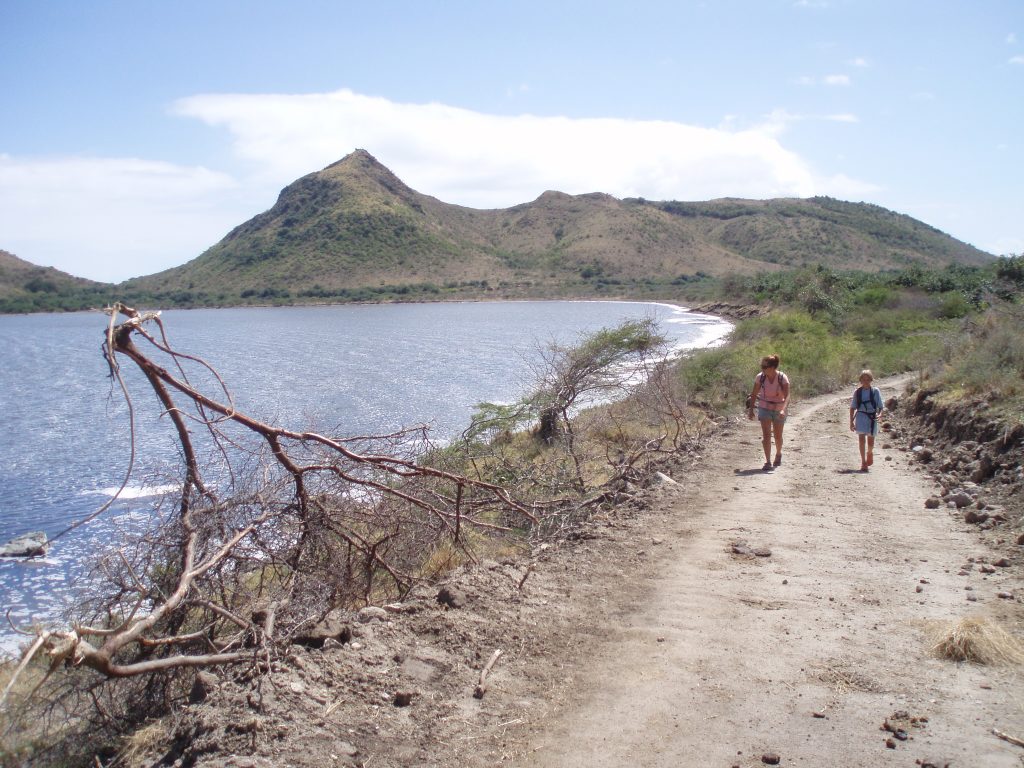
This particular area of St Kitts was very arid, a stark contrast from the lush green hills we experienced on the northern half of the island that encompassed the volcanic peaks.
The old volcanic mountains, reaching high up off of the ocean, create a distinct micro climate all to themselves. Except for the days when there’s no clouds to be found anywhere in the sky, these peaks are usually enshrouded with a big cloud covering the peak. Out of these clouds comes the regular rainfall that produces the lush rain forests and the much needed drinking and irrigation water supply. But the southern end of St Kitts is far from this water source and the hillsides suffer under the tropical heat. Another factor is the wild goats. They are everywhere! And they eat everything in sight!
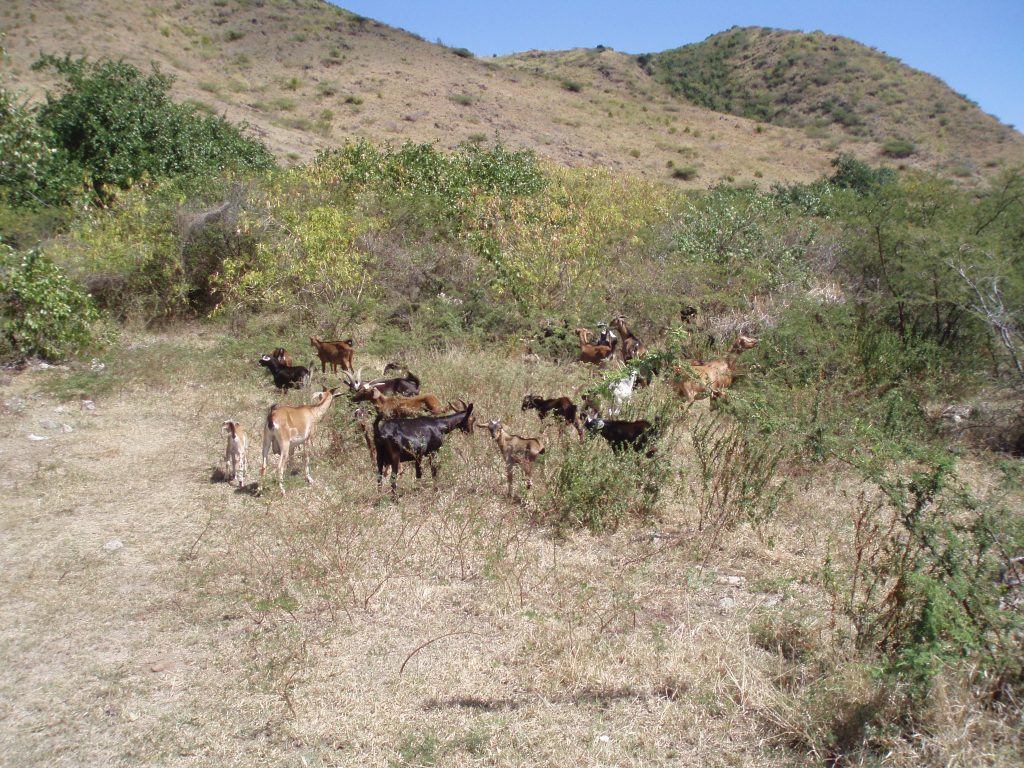
You definitely don’t want to invite these goats over to your house, unless you are looking for a cheap alternative to a bulldozer. They will empty your yard of everything remotely green and leave it looking like a wasteland. Most of the shrubbery on our walk were of the thorny variety, and I was surprised to see these goats pick in and around the thorns to remove every green leaf from every branch. These poor plants were blessed with a natural defense system, but it was no match for the goats of St Kitts! Here’s a picture of the thorns against our youngest’s hand. Some of them were two inches long – yikes!
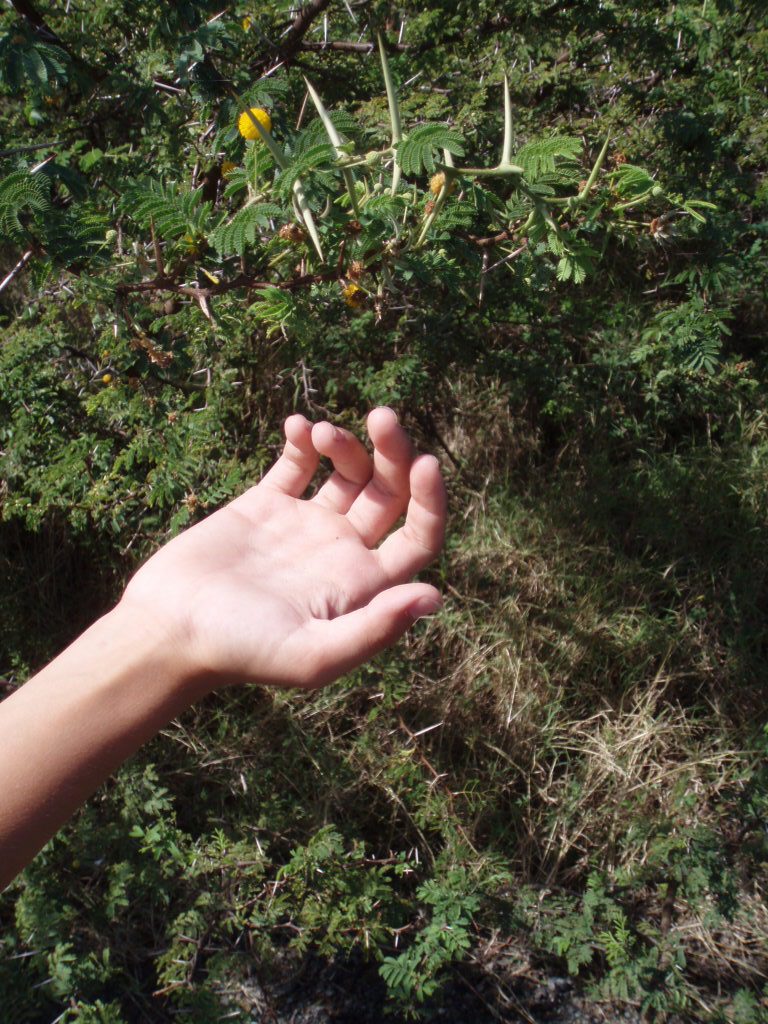
We spent two nights at anchor in White House Bay, the perfectly quiet place to slow down and savor life, your next meal and the impending sunset. But, while that’s what most adults are looking for, kids on the other hand want to shake it up and splash around. Here’s a short video of the boys enjoying some halyard swinging – the next best thing to a rope swing over a country lake!
We finally left the peacefulness of White House Bay early on the third morning for a 40 mile upwind sail to Antigua. Why suffer through an upwind beat, with constant tacking, winch grinding and salt spray showering the cockpit, you might ask? We were having some problems with our engine and there happened to be a shop in Antigua that specializes in our brand of engine – Perkins – and the warranty was supposed to run out shortly. We had not planned on stopped at Antigua, at least on the way down. I had heard it was very busy there, and after St Martin, busy was not what I was looking for, so I tried to steer the family away to other more remote islands. But you quickly learn here on the water that there are greater powers at work then just your own brains and brawn. We were not getting the power out of the engine that we had expected, and I wanted someone to look at the transmission to see if it needed servicing. We figured that if we left at 3am, we should have plenty of time to get to Antigua before dark, and all looked good as we sailed away from our anchorage at White House Bay. There was a gentle breeze pushing us along at 6 knots as we tacked back and forth around several easy to find obstacles off the coast of St Kitts. But then the wind gods began toying with us. By the end of the day, I think we had every weather pattern possible – high winds, fluky winds, no winds, big seas, big seas with multiple wave directions, rain, and then hot-hot sun. We ended up gently motoring the last 12 miles to a spot on the western shore of Antigua called Jolly Harbor. Our friends Hunter and Devi on Arctic Tern were there as well – how great it was to say hello to familiar faces. They had been in Antigua for over a week and were quick to give us the rundown on where to clear through customs, to grocery shop and the best snorkeling spots. If you can’t keep up with your friends, the next best thing is to follow a week or two behind them and get the scoop on what to see and do!
We left the next day for the rest of the leg around to Falmouth Harbor, where most of the boating services are on the island. Antigua hosts several well-known sailing regattas and the boat inventory in Falmouth puts places like Newport, RI to shame! I had never seen so many megayachts – both power and sail – in one place. The amount of nautical wealth floating in the water was staggering. Karen said that when nightfall came and each of the boats light up their decks and their masts, trying to out impress their neighbor, it looked like a nightscape of an oil refinery! It probably took an oil refinery to keep all of those boats fueled up too! It might cost a lot, but we should have no problem getting the engine fixed here!
Our quandary on the engine was a quick and uneventful experience. We had a mechanic come out to the boat and listen to the engine and transmission, and then go for a test drive through the harbor. We ran the engine at max throttle, and other boats were keeping a weary eye on us as we spun through the anchorage at 7+ knots. There was no decipherable problem with the engine. What we had experienced in St Kitts must have been a fluke. The engine was running great and that was one less worry for us.
We spent two days in Falmouth harbor, and after school work was finished by mid-day, we had some great shoreside excursions. Adjacent to Falmouth Harbor is a much smaller but more historical anchorage called English Harbor. It was here that the British navy chose to build in 1745 their largest port to defend their interests in the Caribbean. The harbor has a narrow, easy-to-defend entrance, and provided a safe haven for ship repairs. After the decline of the British in the Caribbean, the harbor facilities fell into disrepair, but in the 1950’s an effort was untaken to restore the grounds around English Harbor, naming it Nelson’s Dockyard after the ex-commander Horatio Nelson. Today, it stands as a fine tribute to British naval history and is a mini-Mystic Seaport with it’s signage of nautical lore. You can even stay in one of the very English looking restored inns.
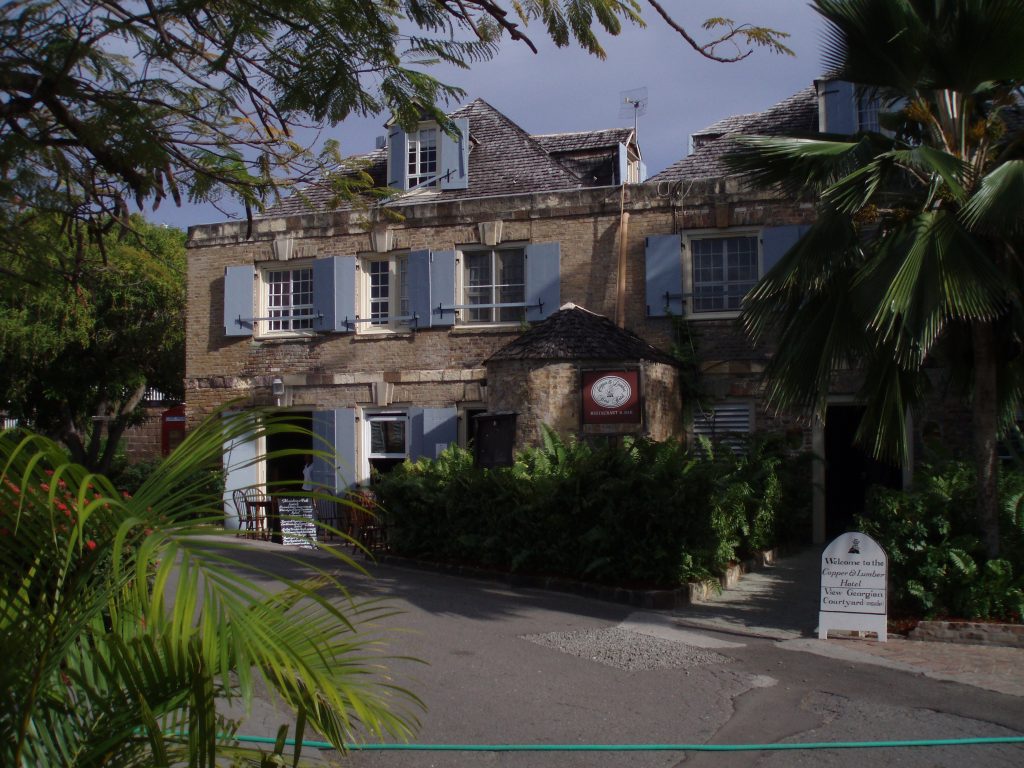
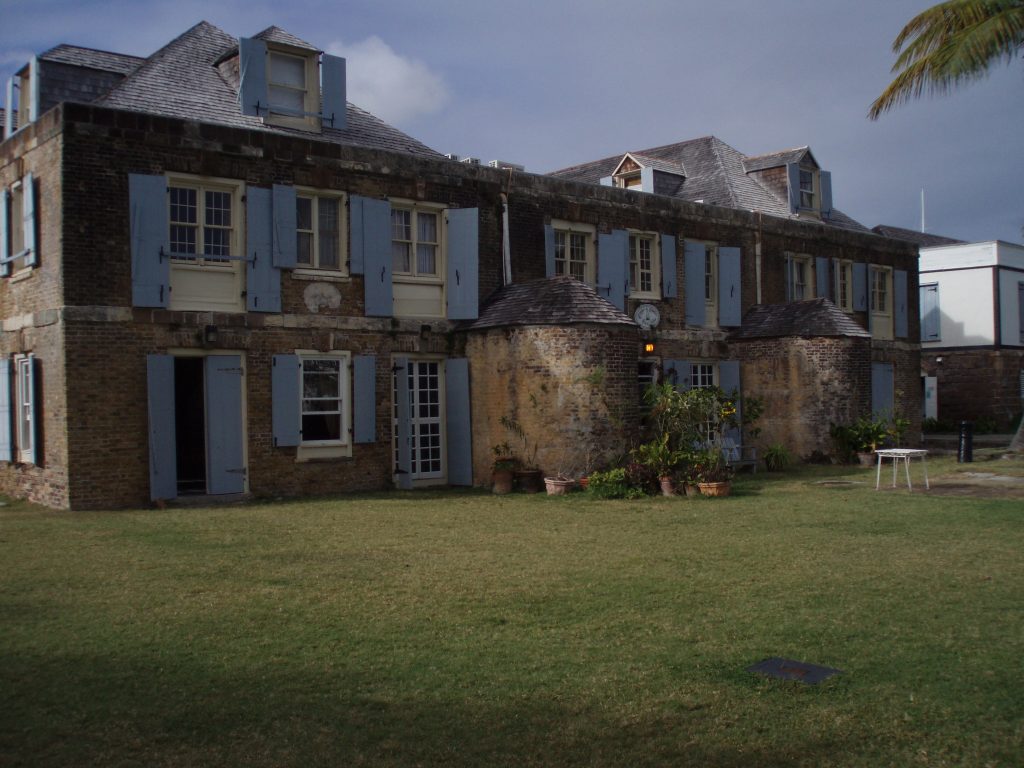
They also built some picturesque hiking trails along the cliffs of the harbor. Here is a look back down the cliff trail, with Fort Berkeley in the center, once used to guard the harbor entrance.
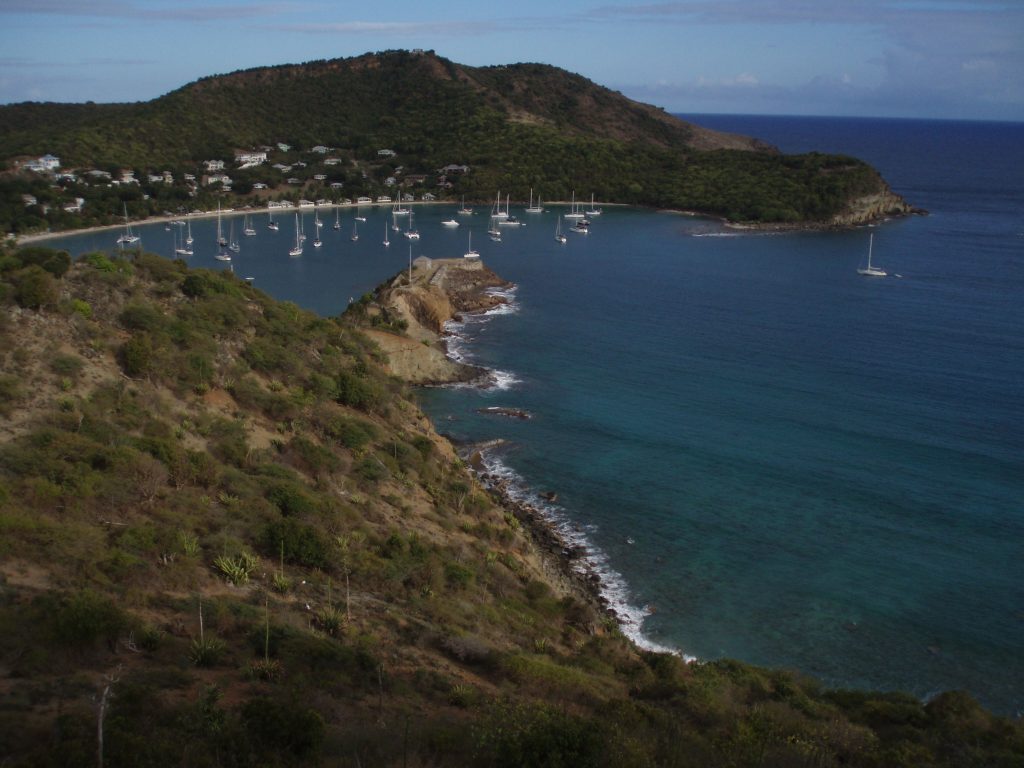
With the engine working fine and a trip to a very small grocery store to stock up, there was no need for us to stay in the pretentious Falmouth/English harbor area. We motored out of the harbor late in the afternoon for a 10 mile trip upwind to Green Island. Arctic Tern and Asseance had highly recommended this spot. It won accolades from us too for its unique anchorage. Here’s what it looked like on the chart. What made it great was the ability to anchor right behind the long Bird Island Reef. This reef calms the big swells and wind waves down to a gentle ripple on the water. So, you lay facing eastward into the open ocean, with a nice cooling breeze, and nothing but water between you and Africa!
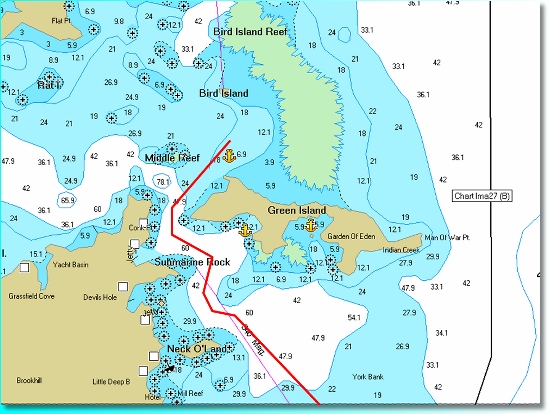
Here’s a picture of the anchorage, too. It is a little hard to see, but if you look closely, you will see waves breaking out to sea. But, only calm waters prevailed where we dropped the hook.

This became another one of those ‘battery-recharging’ spots, where you charge up your human battery with renewed energy and happiness. Antigua was starting to grow on us!
We then moved on to another Arctic and Asseance recommended stop, Great Bird Island, on the northern side of the island. Because of all of the reefs in the area, we ended up sailing at least 20 miles to go what a seagull could fly in about 6 miles. There were only limited spots, as you can understand from the chart below, to get through the many coral reefs on this part of Antigua. This will be good practice for the Bahamas, where the water is chronically shallow and hazardous too!
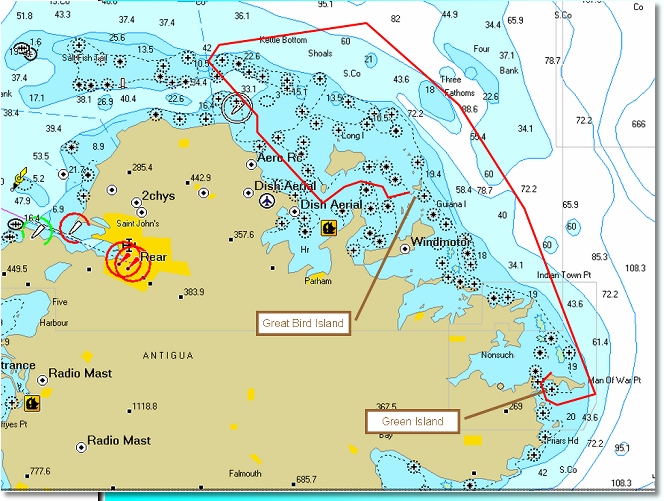
The extra effort was well worth it though. First of all, we had a chance to use our spinnaker, as we sailed on a beam reach most of the way up the coast. And, secondly, Great Bird Island offered up some great snorkeling and beach time. We spent two nights there, with the first night being nearly alone and the second night in the company of about 10 boats – a necessary reminder that we are not alone on this planet!
We plan to stay on for a few more days in Antigua, an island, like St Martin, that we had planned to skip over, but providence brought us together and, in both cases, we were very happy with the result!
